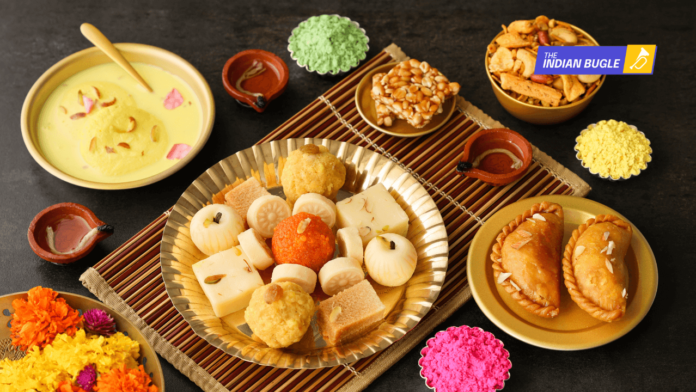Navratri is one of the most sacred Hindu festivals dedicated to the worship of Maa Durga and her nine divine forms, known as Navdurga. Each day, devotees worship a different form of the Goddess and offer a special bhog (prasad) that holds spiritual and symbolic meaning. These offerings not only please the Goddess but also bring health, prosperity, peace, and success into the devotee’s life.
Here’s a complete guide to the 9 days of Navratri bhog, along with a short description of each form of the Goddess and the blessings one receives.
Day 1: Maa Shailputri
- Appearance: Maa Shailputri is depicted riding a bull, holding a trident and a lotus.
- Bhog: Ghee
- Significance: Offering ghee enhances health, brings long life, and ensures well-being.
Day 2: Maa Brahmacharini
- Appearance: The Goddess holds a rosary (japmala) in one hand and a kamandalu in the other, symbolizing penance.
- Bhog: Sugar
- Significance: Sugar as bhog blesses devotees with discipline, restraint, and spiritual strength.
Day 3: Maa Chandraghanta
- Appearance: Maa Chandraghanta is adorned with a crescent moon on her forehead, symbolizing peace and bravery.
- Bhog: Milk and kheer
- Significance: Offering milk or kheer brings peace, harmony, and prosperity.
Day 4: Maa Kushmanda
- Appearance: Known as the creator of the universe, Maa Kushmanda radiates like the sun with eight hands.
- Bhog: Malpua
- Significance: Malpua as bhog enhances intelligence, wisdom, and accomplishment in work.
Day 5: Maa Skandmata
- Appearance: She is depicted carrying her son Kartikeya (Skanda) in her lap, seated on a lion.
- Bhog: Banana
- Significance: Offering bananas ensures family happiness, child blessings, and overall peace at home.
Day 6: Maa Katyayani
- Appearance: Maa Katyayani is a warrior form of Durga, holding weapons and riding a lion.
- Bhog: Honey
- Significance: Honey as prasad brings marital bliss, love, and harmony in relationships.
Day 7: Maa Kalaratri
- Appearance: Fierce and powerful, Maa Kalaratri has a dark complexion, rides a donkey, and destroys evil forces.
- Bhog: Jaggery and coconut
- Significance: Offering jaggery removes fear, eliminates enemies, and grants courage.
Day 8: Maa Mahagauri
- Appearance: Maa Mahagauri is radiant, fair, and serene, riding a bull and holding a trident and damru.
- Bhog: Coconut and white dishes (like white halwa or kheer)
- Significance: This offering brings peace, purity, and relief from past sins.
Day 9: Maa Siddhidatri
- Appearance: The supreme form of Goddess Durga, Maa Siddhidatri grants all siddhis (spiritual powers).
- Bhog: Sesame seeds (til) and coconut
Significance: Offering til and coconut brings prosperity, spiritual growth, and fulfillment of all desires.
Additional Auspicious Offerings During Navratri
- Fresh fruits, flowers, dry fruits, and panchamrit (a mix of milk, curd, honey, ghee, and sugar) are considered highly auspicious.
- Devotees should always offer sattvik food prepared with devotion and purity.
Conclusion
Each day of Navratri holds deep spiritual meaning. By offering the specific bhog to Maa Durga’s nine forms, devotees not only strengthen their devotion but also attract divine blessings for health, peace, success, and prosperity.
This Navratri 2025, celebrate with devotion, follow the rituals, and seek the powerful blessings of Maa Durga in her nine divine forms.
